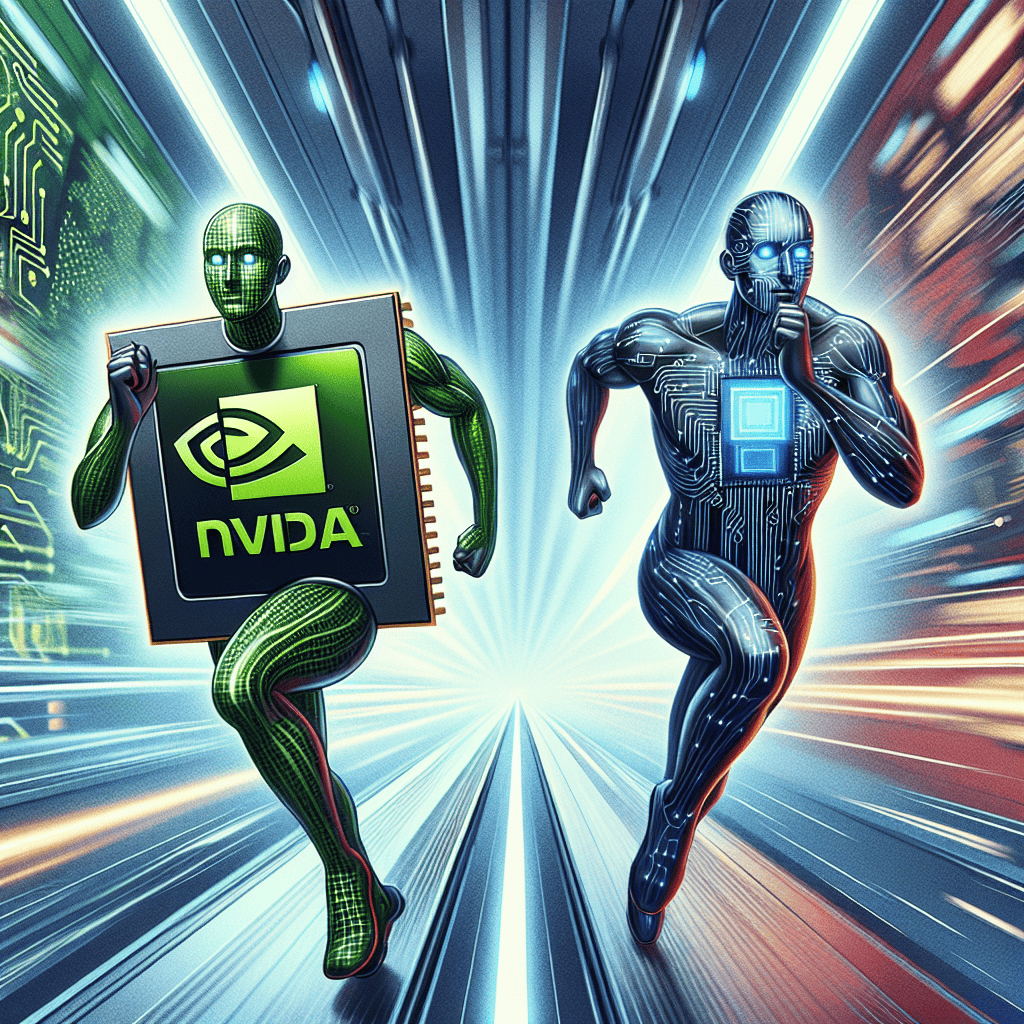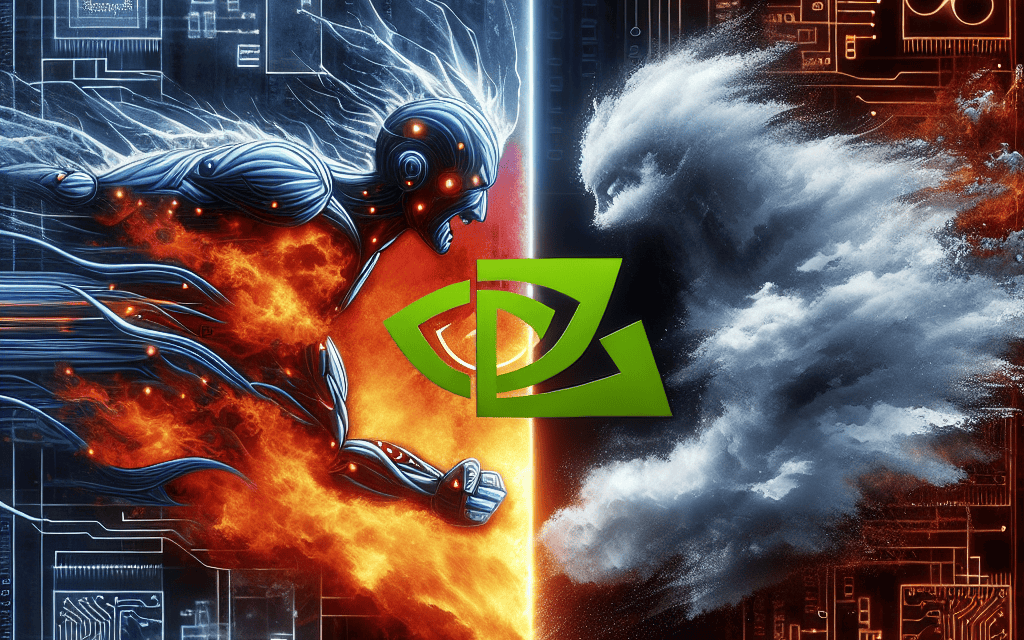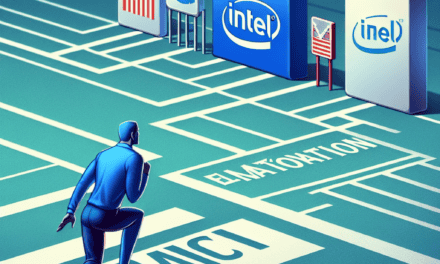“Challenging the Titan: A New Contender Emerges in the AI Arena.”
Introduction
In the rapidly evolving landscape of artificial intelligence, Nvidia has long been a dominant force, renowned for its cutting-edge graphics processing units (GPUs) that power everything from gaming to complex AI computations. However, as the AI revolution accelerates, new challengers are emerging, poised to disrupt Nvidia’s stronghold. These potential rivals are leveraging innovative technologies and strategic partnerships to carve out their own niches in the AI ecosystem. As the competition intensifies, the question arises: has Nvidia finally found a formidable rival in the AI revolution, capable of challenging its supremacy and reshaping the future of AI development?
The Rise of AI Competitors: Challenging Nvidia’s Dominance
In recent years, Nvidia has emerged as a dominant force in the artificial intelligence (AI) sector, particularly in the realm of graphics processing units (GPUs) that power AI computations. The company’s GPUs have become the backbone of AI research and development, providing the computational power necessary for training complex machine learning models. However, as the AI landscape continues to evolve, new competitors are beginning to challenge Nvidia’s supremacy, signaling a potential shift in the industry’s dynamics.
One of the most significant developments in this regard is the emergence of companies that are designing specialized AI chips, often referred to as application-specific integrated circuits (ASICs). These chips are tailored specifically for AI workloads, offering efficiency and performance advantages over general-purpose GPUs. For instance, Google has developed its Tensor Processing Units (TPUs), which are optimized for machine learning tasks and have been integrated into its cloud services. This move not only enhances Google’s AI capabilities but also provides an alternative to Nvidia’s offerings for businesses seeking high-performance AI solutions.
Moreover, other tech giants like Amazon and Microsoft are investing heavily in developing their own AI hardware. Amazon’s AWS Inferentia and Microsoft’s Project Brainwave are examples of initiatives aimed at creating custom AI accelerators. These efforts underscore a growing trend where companies are seeking to reduce their reliance on Nvidia by building in-house solutions that cater to their specific needs. This shift is further fueled by the increasing demand for AI applications across various industries, from healthcare to autonomous vehicles, which necessitates more diverse and specialized hardware solutions.
In addition to these tech behemoths, a wave of startups is also entering the fray, bringing innovative approaches to AI hardware. Companies like Graphcore, Cerebras Systems, and Habana Labs are developing novel architectures that promise to deliver unprecedented levels of performance for AI tasks. These startups are attracting significant investment, indicating strong confidence in their potential to disrupt the market. Their focus on creating chips that are not only powerful but also energy-efficient addresses a critical challenge in AI computing, where power consumption and heat generation are major concerns.
Despite these emerging challenges, Nvidia remains a formidable player in the AI hardware market. The company continues to innovate, with its latest GPUs offering cutting-edge features and capabilities that keep it at the forefront of AI technology. Furthermore, Nvidia’s acquisition of ARM, a leading semiconductor design company, positions it to expand its influence in the AI ecosystem by integrating ARM’s low-power processing capabilities with its own high-performance GPUs.
Nevertheless, the rise of competitors signifies a more competitive landscape, which could lead to faster advancements in AI technology. As companies vie for dominance, the resulting innovation could benefit consumers and businesses alike, driving down costs and increasing the accessibility of AI tools. This competition also encourages Nvidia to push the boundaries of what is possible, ensuring that it does not rest on its laurels.
In conclusion, while Nvidia has long been the leader in AI hardware, the emergence of new competitors is reshaping the industry. The development of specialized AI chips by both established tech giants and nimble startups presents a formidable challenge to Nvidia’s dominance. As the AI revolution continues to unfold, it remains to be seen whether Nvidia can maintain its leadership position or if a new contender will rise to claim the crown.
Nvidia’s Market Position: Is It Under Threat?
Nvidia has long been a dominant force in the realm of artificial intelligence, particularly in the development and deployment of graphics processing units (GPUs) that power AI applications. The company’s GPUs have become the backbone of AI research and development, providing the computational power necessary for training complex machine learning models. However, as the AI landscape continues to evolve, questions have arisen regarding whether Nvidia’s market position is under threat from emerging competitors.
In recent years, several companies have entered the AI hardware market, aiming to challenge Nvidia’s supremacy. Among these, AMD and Intel have made significant strides in developing their own AI-focused hardware solutions. AMD, for instance, has been enhancing its GPU offerings with a focus on AI and machine learning capabilities. The company’s Radeon Instinct line of GPUs is designed to cater to the needs of AI researchers and developers, offering competitive performance at potentially lower costs. Similarly, Intel has been investing heavily in AI, acquiring companies like Habana Labs to bolster its AI hardware portfolio. Intel’s Xeon processors and AI accelerators are increasingly being positioned as viable alternatives to Nvidia’s offerings.
Moreover, the rise of specialized AI hardware companies presents another layer of competition. Companies like Graphcore and Cerebras Systems are developing innovative AI processors that promise to deliver unprecedented performance for specific AI workloads. These companies are leveraging novel architectures and technologies to optimize AI computations, potentially offering more efficient solutions than traditional GPUs. As these specialized processors gain traction, they could pose a significant challenge to Nvidia’s dominance in certain segments of the AI market.
In addition to these competitors, the open-source hardware movement is gaining momentum, further complicating the competitive landscape. The RISC-V architecture, for example, is an open-source hardware instruction set architecture that allows companies to design custom processors tailored to their specific needs. This flexibility could enable new entrants to develop AI hardware solutions that are both cost-effective and highly optimized for particular applications, potentially eroding Nvidia’s market share.
Despite these emerging threats, Nvidia remains a formidable player in the AI hardware market. The company continues to innovate, releasing new generations of GPUs that push the boundaries of performance and efficiency. Nvidia’s CUDA platform, a parallel computing architecture, remains a critical tool for AI developers, providing a robust ecosystem that supports a wide range of AI applications. Furthermore, Nvidia’s strategic partnerships and acquisitions, such as the purchase of Mellanox Technologies, have strengthened its position in the data center market, a key area for AI deployment.
Nevertheless, the competitive landscape is shifting, and Nvidia must remain vigilant to maintain its leadership position. The company’s ability to adapt to new technological trends and respond to the strategies of its competitors will be crucial in determining its future success. As AI continues to revolutionize industries, the demand for powerful and efficient hardware solutions will only grow, providing both opportunities and challenges for Nvidia and its rivals.
In conclusion, while Nvidia currently holds a strong position in the AI hardware market, the emergence of new competitors and technologies suggests that its dominance is not unassailable. The company must continue to innovate and adapt to the changing landscape to fend off these challenges and secure its place in the AI revolution. As the battle for AI hardware supremacy intensifies, the coming years will be pivotal in determining whether Nvidia can maintain its leadership or if a new rival will emerge to challenge its reign.
Emerging Technologies: Rivals in the AI Hardware Space
In the rapidly evolving landscape of artificial intelligence, Nvidia has long been a dominant force, particularly in the realm of AI hardware. Known for its powerful graphics processing units (GPUs), Nvidia has become synonymous with high-performance computing, driving advancements in machine learning and deep learning applications. However, as the AI revolution continues to gain momentum, the question arises: has Nvidia finally found a rival in this burgeoning field?
To address this question, it is essential to consider the broader context of the AI hardware space, which has seen a surge of innovation and competition in recent years. Companies across the globe are investing heavily in developing cutting-edge technologies to capture a share of this lucrative market. Among these emerging competitors, several have shown promise in challenging Nvidia’s dominance.
One such contender is AMD, a company that has historically been Nvidia’s primary competitor in the GPU market. AMD has made significant strides in recent years, particularly with its Radeon Instinct line of GPUs, which are designed specifically for AI and machine learning workloads. By leveraging its expertise in high-performance computing and its competitive pricing strategy, AMD has positioned itself as a formidable rival to Nvidia. Moreover, AMD’s recent collaborations with major tech companies have further bolstered its standing in the AI hardware arena.
In addition to AMD, other tech giants are also making their presence felt. Google, for instance, has developed its own custom AI hardware known as the Tensor Processing Unit (TPU). These TPUs are optimized for machine learning tasks and have been integrated into Google’s cloud services, offering an alternative to Nvidia’s GPU-based solutions. Google’s entry into the AI hardware market underscores the growing trend of companies developing specialized chips tailored to specific AI applications, thereby intensifying the competition.
Furthermore, startups and smaller companies are also contributing to the competitive landscape. Companies like Graphcore and Cerebras Systems are pioneering novel approaches to AI hardware, focusing on innovative architectures that promise to deliver unprecedented performance. Graphcore’s Intelligence Processing Unit (IPU) and Cerebras’ Wafer-Scale Engine (WSE) are examples of how these companies are pushing the boundaries of what is possible in AI computing. Their efforts highlight the dynamic nature of the industry, where new players can quickly emerge as significant challengers.
Despite the increasing competition, Nvidia remains a formidable player, continually innovating and expanding its product offerings. The company’s recent advancements in AI hardware, such as the introduction of the A100 Tensor Core GPU, demonstrate its commitment to maintaining its leadership position. Nvidia’s strategic acquisitions, like that of ARM, further indicate its intent to diversify and strengthen its capabilities in the AI domain.
In conclusion, while Nvidia continues to hold a prominent position in the AI hardware space, the emergence of strong competitors suggests that the landscape is becoming more competitive. Companies like AMD, Google, and various startups are challenging Nvidia’s dominance by offering alternative solutions and pushing the boundaries of AI hardware innovation. As the AI revolution progresses, it will be intriguing to observe how these dynamics unfold and whether Nvidia can sustain its leadership amidst the growing competition. Ultimately, this increased rivalry is likely to drive further advancements in AI technology, benefiting the industry as a whole.
The Impact of New AI Startups on Nvidia’s Strategy

In recent years, Nvidia has established itself as a dominant force in the realm of artificial intelligence, particularly in the development of GPUs that power AI applications. However, the landscape of AI technology is rapidly evolving, and new startups are emerging with innovative solutions that could potentially challenge Nvidia’s stronghold. As these startups gain traction, they are beginning to influence Nvidia’s strategic decisions, prompting the tech giant to adapt in order to maintain its competitive edge.
One of the key factors driving the rise of AI startups is the increasing demand for specialized AI hardware. While Nvidia’s GPUs have been the go-to choice for many AI researchers and developers, startups are now exploring alternative architectures that promise greater efficiency and performance. For instance, companies like Graphcore and Cerebras Systems are developing AI-specific chips that offer significant advantages in terms of speed and power consumption. These advancements are compelling Nvidia to reassess its product offerings and explore new avenues for innovation.
Moreover, the competitive pressure from these startups is not limited to hardware alone. Many of these new entrants are also focusing on software solutions that optimize AI workloads. By developing cutting-edge algorithms and frameworks, they are enabling more efficient use of existing hardware, thereby reducing the reliance on Nvidia’s GPUs. This shift in focus is encouraging Nvidia to invest more heavily in software development, as evidenced by its recent acquisitions and partnerships aimed at enhancing its AI software ecosystem.
In addition to technological advancements, the business models of these startups are also influencing Nvidia’s strategy. Many of these companies are adopting a more open and collaborative approach, offering their technologies as open-source solutions or through partnerships with other tech firms. This contrasts with Nvidia’s traditionally more closed ecosystem, prompting the company to reconsider its approach to collaboration and community engagement. By fostering a more open environment, Nvidia hopes to attract a broader range of developers and researchers, thereby strengthening its position in the AI market.
Furthermore, the rise of AI startups is also impacting Nvidia’s approach to market segmentation. As these new companies target specific industries and applications, Nvidia is being pushed to diversify its product offerings to cater to a wider array of use cases. This has led to the development of specialized GPUs and software solutions tailored to sectors such as healthcare, automotive, and finance. By expanding its reach into these niche markets, Nvidia aims to capture a larger share of the growing AI industry.
Despite the challenges posed by these emerging startups, Nvidia remains a formidable player in the AI space. Its extensive experience, established brand, and robust infrastructure provide it with a significant advantage over newer entrants. However, the company cannot afford to rest on its laurels. The rapid pace of innovation in the AI sector necessitates continuous adaptation and evolution.
In conclusion, while Nvidia has long been a leader in the AI revolution, the emergence of new startups is reshaping the competitive landscape. These companies are driving technological advancements, influencing business models, and prompting Nvidia to rethink its strategy. As the AI industry continues to evolve, it will be crucial for Nvidia to remain agile and responsive to these changes in order to maintain its leadership position. The coming years will undoubtedly be pivotal in determining whether Nvidia can successfully navigate this new era of competition.
Comparing AI Innovations: Nvidia Versus the New Contenders
In the rapidly evolving landscape of artificial intelligence, Nvidia has long been a dominant force, renowned for its cutting-edge graphics processing units (GPUs) that have become the backbone of AI research and development. However, as the AI revolution continues to gain momentum, new contenders are emerging, challenging Nvidia’s supremacy and introducing innovative technologies that could reshape the industry. This dynamic shift raises the question: has Nvidia finally found a rival in the AI revolution?
To understand the current competitive landscape, it is essential to examine the technological advancements and strategic maneuvers of these new contenders. Companies such as AMD, Intel, and Google have made significant strides in AI hardware, each bringing unique strengths to the table. AMD, for instance, has been leveraging its expertise in high-performance computing to develop GPUs that rival Nvidia’s offerings. With a focus on energy efficiency and cost-effectiveness, AMD’s products are increasingly appealing to businesses seeking alternatives to Nvidia’s often premium-priced solutions.
Meanwhile, Intel has been investing heavily in AI-specific hardware, notably through its acquisition of Habana Labs, a company specializing in AI accelerators. This move underscores Intel’s commitment to diversifying its portfolio and enhancing its AI capabilities. By integrating Habana’s technology, Intel aims to provide a comprehensive suite of AI solutions that cater to a wide range of applications, from data centers to edge computing. This strategic expansion positions Intel as a formidable competitor, capable of challenging Nvidia’s dominance in the AI hardware market.
In addition to these traditional semiconductor giants, tech behemoths like Google are also entering the fray with their own innovations. Google’s Tensor Processing Units (TPUs) are specifically designed to accelerate machine learning tasks, offering an alternative to Nvidia’s GPUs. By optimizing TPUs for Google’s own AI frameworks, such as TensorFlow, the company is not only enhancing its cloud services but also providing developers with powerful tools to build and deploy AI models efficiently. This vertical integration of hardware and software gives Google a competitive edge, potentially disrupting Nvidia’s stronghold in the AI ecosystem.
Furthermore, the rise of specialized AI startups cannot be overlooked. Companies like Graphcore and Cerebras Systems are pioneering novel approaches to AI hardware, focusing on architectures that promise unprecedented performance gains. Graphcore’s Intelligence Processing Unit (IPU) and Cerebras’ Wafer-Scale Engine (WSE) represent radical departures from traditional GPU designs, offering tailored solutions for specific AI workloads. These innovations highlight the growing trend towards specialization in AI hardware, challenging Nvidia to continuously innovate and adapt to maintain its leadership position.
Despite these emerging challenges, Nvidia remains a formidable player, consistently pushing the boundaries of AI technology. The company’s recent advancements in AI software, such as the development of its CUDA platform and the introduction of AI frameworks like NVIDIA Clara and NVIDIA Jarvis, demonstrate its commitment to providing comprehensive solutions that extend beyond hardware. By fostering a robust ecosystem that integrates hardware, software, and services, Nvidia continues to solidify its position as a leader in the AI revolution.
In conclusion, while Nvidia faces increasing competition from both established companies and innovative startups, it remains a dominant force in the AI industry. The emergence of new contenders has undoubtedly intensified the race for AI supremacy, driving technological advancements and fostering a more dynamic and competitive market. As these companies continue to innovate and refine their offerings, the AI landscape will likely witness further transformations, ultimately benefiting consumers and accelerating the pace of AI development.
Strategic Partnerships: How Nvidia’s Rivals Are Gaining Ground
In the rapidly evolving landscape of artificial intelligence, Nvidia has long been a dominant force, renowned for its cutting-edge graphics processing units (GPUs) that power everything from gaming to complex AI computations. However, as the AI revolution continues to unfold, strategic partnerships are emerging as a critical factor in leveling the playing field, allowing Nvidia’s rivals to gain significant ground. These collaborations are reshaping the competitive dynamics of the industry, offering new opportunities for companies to challenge Nvidia’s supremacy.
One of the most notable examples of this trend is the partnership between AMD and Xilinx. By joining forces, AMD has been able to leverage Xilinx’s expertise in field-programmable gate arrays (FPGAs), which are increasingly being used in AI applications due to their flexibility and efficiency. This collaboration has enabled AMD to enhance its product offerings, providing a viable alternative to Nvidia’s GPUs. The synergy between AMD’s processing power and Xilinx’s adaptable technology has resulted in a formidable competitor that is gaining traction in the AI market.
Similarly, Intel’s acquisition of Habana Labs has positioned the company as a serious contender in the AI space. Habana Labs, known for its innovative AI processors, has brought a fresh perspective to Intel’s portfolio. This strategic move has allowed Intel to integrate Habana’s specialized AI chips with its own technology, creating a comprehensive suite of solutions that cater to a wide range of AI applications. As a result, Intel is now better equipped to compete with Nvidia, offering customers a diverse array of options that can be tailored to specific needs.
Moreover, the collaboration between Google and Broadcom highlights another strategic partnership that is challenging Nvidia’s dominance. By working together, Google and Broadcom have developed custom AI chips that are optimized for Google’s data centers. These chips, known as tensor processing units (TPUs), are designed to accelerate machine learning tasks, providing a competitive edge in terms of performance and efficiency. This partnership not only strengthens Google’s AI capabilities but also positions Broadcom as a key player in the AI hardware market, further intensifying the competition.
In addition to these high-profile partnerships, smaller companies are also making strategic alliances to bolster their positions in the AI industry. For instance, Graphcore, a UK-based startup, has partnered with Microsoft to integrate its intelligence processing units (IPUs) into Microsoft’s Azure cloud platform. This collaboration has allowed Graphcore to reach a broader audience and compete with established players like Nvidia. By aligning with a major cloud provider, Graphcore has gained access to valuable resources and expertise, enabling it to refine its technology and expand its market presence.
As these strategic partnerships continue to evolve, they are reshaping the competitive landscape of the AI industry. While Nvidia remains a formidable leader, the emergence of these alliances is creating a more dynamic and competitive environment. Companies are increasingly recognizing the value of collaboration, leveraging each other’s strengths to develop innovative solutions that challenge the status quo. This shift not only benefits the companies involved but also drives innovation and progress in the AI field as a whole.
In conclusion, strategic partnerships are proving to be a powerful tool for Nvidia’s rivals, allowing them to gain ground in the AI revolution. By joining forces with other companies, these competitors are enhancing their capabilities and expanding their reach, creating a more competitive and vibrant industry. As the AI landscape continues to evolve, it will be fascinating to see how these partnerships shape the future of technology and influence the balance of power in the market.
Future Predictions: Will Nvidia Maintain Its AI Leadership?
As the artificial intelligence (AI) landscape continues to evolve at a rapid pace, Nvidia has long been at the forefront, dominating the market with its powerful graphics processing units (GPUs) that are essential for AI computations. However, the question arises: has Nvidia finally found a rival in the AI revolution? To explore this, it is crucial to examine the current market dynamics, emerging competitors, and the potential future trajectory of Nvidia’s leadership in AI.
Nvidia’s dominance in the AI sector is largely attributed to its early recognition of the potential of GPUs in deep learning applications. By investing heavily in research and development, Nvidia has consistently delivered cutting-edge technology that meets the growing demands of AI workloads. Its CUDA platform, a parallel computing architecture, has become the industry standard, enabling developers to harness the full power of Nvidia’s GPUs. This has solidified Nvidia’s position as a leader in AI hardware, with its products being widely adopted across various industries, from autonomous vehicles to healthcare.
However, the competitive landscape is shifting. Companies like AMD, Intel, and Google are making significant strides in AI hardware, each bringing unique strengths to the table. AMD, for instance, has been enhancing its GPU offerings, focusing on high-performance computing and AI applications. With its recent advancements in architecture and processing power, AMD is positioning itself as a formidable competitor. Meanwhile, Intel is leveraging its expertise in CPUs and field-programmable gate arrays (FPGAs) to develop AI accelerators that promise to deliver efficient performance for specific AI tasks. Google’s Tensor Processing Units (TPUs) are also gaining traction, particularly in cloud-based AI services, offering an alternative to Nvidia’s solutions.
In addition to these established players, a wave of startups is emerging, aiming to disrupt the AI hardware market. Companies like Graphcore, Cerebras Systems, and Habana Labs are developing innovative AI chips designed to optimize performance and energy efficiency. These startups are attracting significant investment and attention, suggesting that the AI hardware market is ripe for disruption.
Despite these challenges, Nvidia remains well-positioned to maintain its leadership in AI. The company continues to innovate, recently unveiling its latest GPU architecture, which promises substantial improvements in performance and efficiency. Furthermore, Nvidia’s strategic acquisitions, such as the purchase of Mellanox Technologies and Arm Holdings, are expected to bolster its capabilities in data center networking and edge computing, respectively. These moves indicate Nvidia’s commitment to expanding its influence across the AI ecosystem.
Moreover, Nvidia’s strong relationships with major tech companies and its extensive developer community provide a competitive edge. By fostering collaborations and offering comprehensive support, Nvidia ensures that its technology remains integral to AI development. This ecosystem approach not only strengthens Nvidia’s market position but also creates barriers for new entrants.
Looking ahead, the AI hardware market is poised for continued growth, driven by increasing demand for AI applications across various sectors. While Nvidia faces mounting competition, its established presence, ongoing innovation, and strategic initiatives suggest that it is well-equipped to navigate the evolving landscape. However, the emergence of new players and technologies means that Nvidia cannot afford complacency. To maintain its leadership, Nvidia must continue to anticipate market trends, invest in research and development, and adapt to the changing needs of AI developers and users.
In conclusion, while Nvidia currently holds a dominant position in the AI revolution, the competitive landscape is becoming increasingly dynamic. The company’s ability to sustain its leadership will depend on its capacity to innovate and respond to emerging challenges. As the AI hardware market evolves, it will be fascinating to observe how Nvidia and its rivals shape the future of AI technology.
Q&A
1. **Question:** Who is considered Nvidia’s main rival in the AI hardware market?
**Answer:** AMD (Advanced Micro Devices) is often considered a main rival to Nvidia in the AI hardware market.
2. **Question:** What technology is central to Nvidia’s dominance in AI?
**Answer:** Nvidia’s dominance in AI is largely due to its advanced GPU (Graphics Processing Unit) technology.
3. **Question:** Which company has been making significant strides in AI chip development to challenge Nvidia?
**Answer:** Companies like AMD, Intel, and Google have been making significant strides in AI chip development to challenge Nvidia.
4. **Question:** What is a key factor that could determine a company’s success in rivaling Nvidia in AI?
**Answer:** A key factor is the ability to develop and produce high-performance, efficient AI chips that can compete with Nvidia’s offerings.
5. **Question:** How has Nvidia maintained its leadership in the AI market?
**Answer:** Nvidia has maintained its leadership through continuous innovation, strategic partnerships, and a strong ecosystem of software and hardware solutions.
6. **Question:** What role do software ecosystems play in Nvidia’s competitive advantage?
**Answer:** Nvidia’s comprehensive software ecosystem, including CUDA and other AI frameworks, provides a significant competitive advantage by enabling developers to optimize and deploy AI applications effectively.
7. **Question:** What is a potential threat to Nvidia’s position in the AI market?
**Answer:** A potential threat is the emergence of new technologies or companies that can offer more cost-effective or superior AI solutions, potentially disrupting Nvidia’s market dominance.
Conclusion
Nvidia has long been a dominant force in the AI hardware market, particularly with its GPUs being integral to AI training and deployment. However, recent developments suggest that it may be facing increasing competition. Companies like AMD, Intel, and emerging startups are investing heavily in AI-specific hardware, aiming to capture a share of this lucrative market. Additionally, tech giants such as Google and Amazon are developing their own AI chips, potentially reducing their reliance on Nvidia. While Nvidia continues to innovate and maintain a strong market position, the growing interest and investment in AI hardware by other companies indicate that it may not remain unchallenged. The AI revolution is likely to see a more competitive landscape, with multiple players vying for leadership, which could drive further innovation and potentially lead to more diverse and cost-effective solutions for AI applications.





